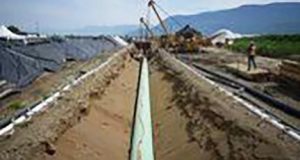By Sandi Krasowski
Local Journalism Initiative Reporter
An analysis of the City of Thunder Bay is underway to explore how Indigenous spending supports the growth and development of the city as a regional service hub.
A joint effort between the Thunder Bay Community Economic Development Commission (CEDC), Fort William First Nation, Anishnawbe Business Professional Association (ABPA) and the Nishnawbe Aski Development Fund (NADF) will work in collaboration with Indigenous and Community Engagement (ICE) Inc. and Big River Analytics (BRA) who will serve as the vendor for the analysis.
Jamie Taylor, the CEDC chief executive officer, said the collaboration is a significant step forward in shaping a sustainable future for Thunder Bay.“When we talk about building a sustainable future for Thunder Bay, if you look at our strategic plan, we have a pillar that is strengthening the community and we feel that this information will be very significant in terms of the economic impact that our Indigenous communities and people bring to our community,”
Taylor said.“It’s really about emphasizing that as a positive contribution to our economy and we really need to value that.”
She added that the shared insights will help build bridges toward economic growth that recognizes our diverse cultural network and drive economic reconciliation.`
`Together, we are charting a course towards a future where Thunder Bay thrives as a model of collaboration, diversity, and sustainable development,” she said.Jason Rasevych, president of the Anishnawbe Business Professional Association, says they have been working behind the scenes for quite some time to provide the structure for the analysis.
“It’s been a work in progress over the last few years to get a better understanding of certain gaps related to Indigenous involvement and ensuring that there’s inclusion,” Rasevych said.“What we’re looking at in the study is the contribution of Indigenous people, businesses and other decision-makers on the Indigenous spend in Thunder Bay, which we feel is significant but based on assumption. We don’t have hard numbers or quantitative information on this.”
Rasevych says Indigenous organizations and businesses have been spending in Thunder Bay for tourism, travel, hospitality, health care, and shopping and amid this Indigenous contribution, the value behind it hasn’t been quantified yet.
“Developing this baseline is going to be important at a high level to get a balanced understanding of the contributions that Indigenous First Nations citizens are making here in Thunder Bay,” he said. “Potentially, that data will expand to Northwestern Ontario to showcase the importance around spending to keep certain industries booming or stabilized while in a sustainable way.”
According to a study from the Canadian Council of Aboriginal Business a few years ago, the Indigenous economy defined by “Indigenous spend” across Canada was pegged at $24 billion and was set to grow to $100 billion over the next few years.
“For us to be able to carve out what the spend is in Thunder Bay is where we’re demystifying some of those misconceptions about Indigenous peoples and Indigenous business,” Rasevych said.
Brian Davey, chief executive officer of Nishnawbe Aski Development Fund, said uncovering the Indigenous economic contribution is important because they are contributors to the wealth generation of this area.“That information is also useful to fill in some of the gaps and allow us to scale that we’re good at,” he said. “If we notice ourselves being more active in hotel acquisitions, then maybe that’s a model to put together that works very well for us. So let’s do more of them.”
Davey added that the data can capture the markets supported by the Indigenous spend, and combined with their knowledge of their communities, can help align Indigenous entrepreneurs to be in a better position to set themselves up to be the sellers.The comprehensive analysis will evaluate key metrics, which include total gross output, total GDP, total labour income, indirect taxes, and jobs created by Indigenous businesses.
The study will assess the economic impact of spending associated with Thunder Bay’s status as the regional hub for northern Indigenous communities.
Sandi Krasowski/ Local Journalism Initiative Reporter/THE CHRONICLE-JOURNAL/LJI is a federally funded program
 Aboriginal Business Magazine Your source for Aboriginal Business News
Aboriginal Business Magazine Your source for Aboriginal Business News





